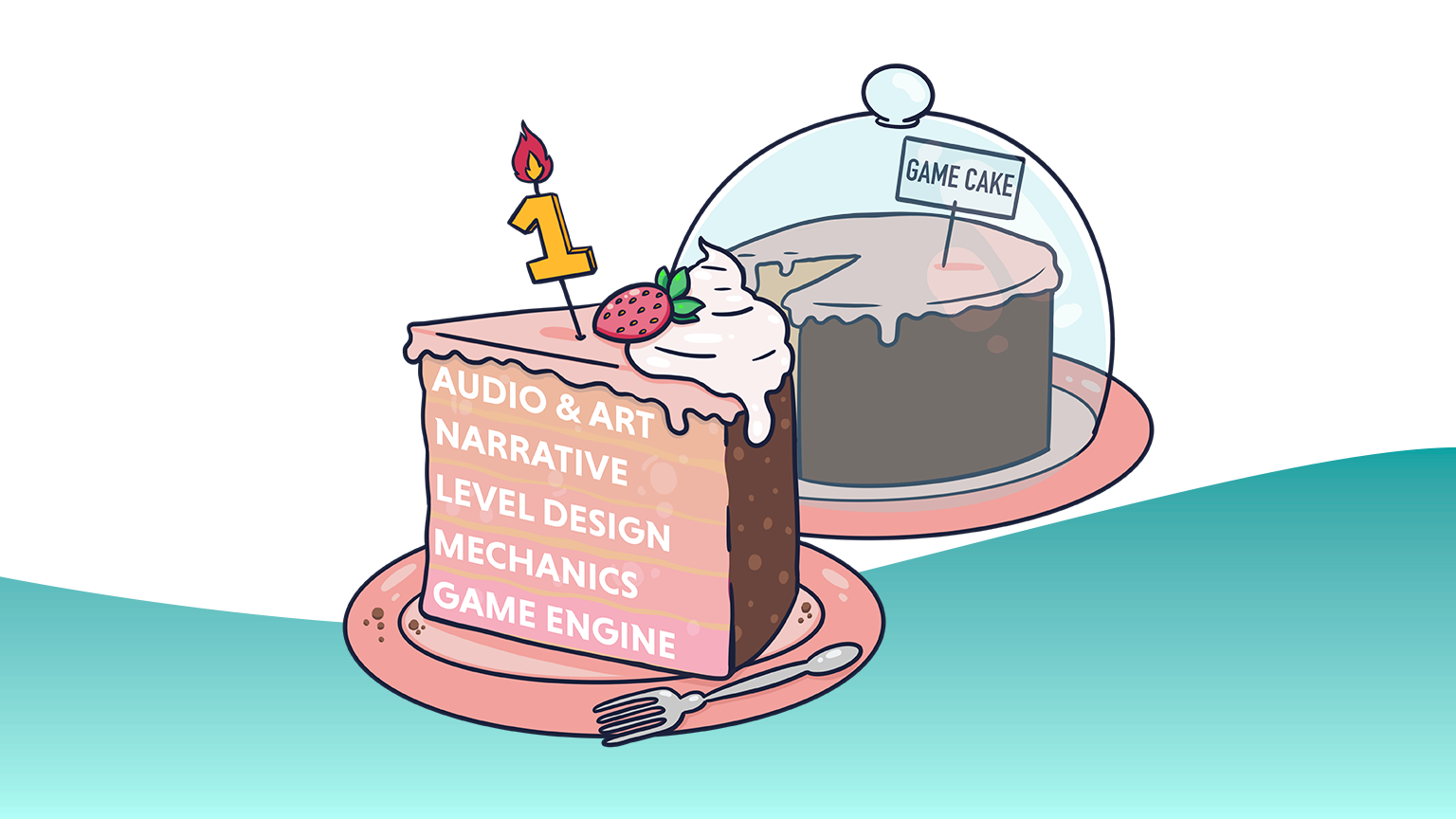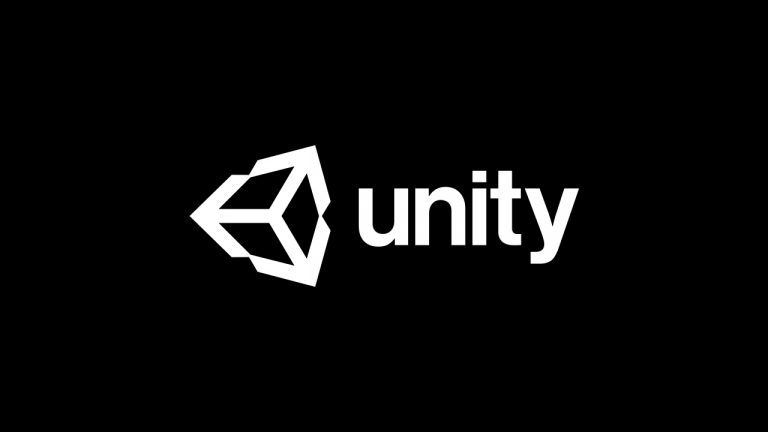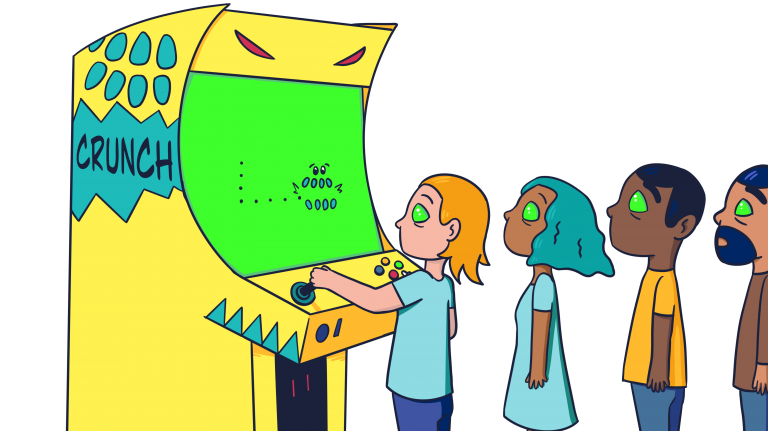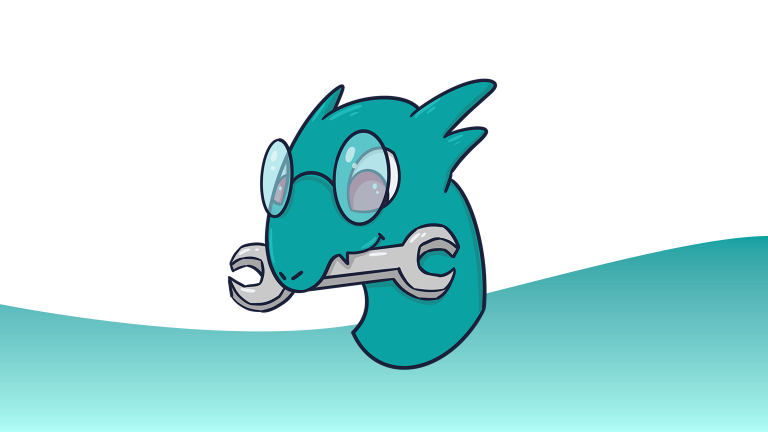Vertical Slice vs MVP: What’s the Difference?
When talking to teams that are early in the development process, they often tell us they want to make either a vertical slice or an MVP (minimum viable product) of their game. We find these two terms get used interchangeably when in fact, they are very different. To clear up any confusion, let’s take a look at what the two terms mean. And better yet, how to use the concepts behind them to make a great game.
It’s important to mention, one of the biggest problems in the games industry is a lack of consistent definitions. A term that clearly means one thing at studio A can mean something completely different at studio B. This is compounded by the fact that similar terms are used outside of the games industry in ways that are more different still. For this article, we used a pinch of research, a dollop of experience, and a dash of common sense to try and give broadly applicable definitions. Consider yourself warned that they may not line up with your personal definitions.
What Is a Vertical Slice?

A vertical slice is a portion of a game that displays a cross-section of the technology, features, mechanics, art, and audio one can expect to find in the final version of that game. Presented at (or near) production quality. A vertical slice may be playable (such as a demo), it may be a video (as is the case with gameplay trailers), or some mixture of the two. Vertical slices need to show the full depth of a game’s mechanics while remaining limited in scope.
If you were making a demo of a Super Mario game, for instance, you would not make multiple worlds that can be played through with every character. Instead, you would develop a small number of levels, possibly as few as a single level. That level would need to include all of the core mechanics one would expect of a finished Mario game such as platforms to be jumped, pipes to be traveled through, coins to be collected, powerups to use, enemies to fight, and maybe even a boss to defeat at the end. In addition, you would need to make sure that any art and music in those levels are also indicative of the final product.
Demos used to be extremely common in the early days of the industry (remember the demo disks that came with gaming magazines?) but have become less-and-less common in recent times with the rise of early-access (more about that later).
Example: Metal Gear Solid 2 Reveal
The MGS2 reveal is a great example of a vertical slice reveal trailer. It includes most of the important aspects of the game. Including cinematic and hyper-dramatic cutscenes (an important part of any modern Hideo Kojima game). And, it did so while limiting itself to content that would eventually be included in the final game and is also exclusively from the first level (a particularly clever trick if you’ve ever played MGS2).
What Is the Purpose of a Vertical Slice?
A vertical slice is used to indicate to stakeholders what the final game will look like. And may also serve to validate the work that has already been done on the game.
The most common reason a vertical slice is developed is in order to build hype for a game or to secure investment. Gameplay reveals at a major convention serve as marketing tools to get consumers excited about the game, and pitch videos or demos can be used to raise funding from publishers or on platforms like Kickstarter.
Vertical slices can also be used to elicit feedback or to extract learnings about how the game plays. But, those are often secondary goals.
Finally, vertical slices often serve as major milestones in the production of a game and can be used as a template for production going forward. By virtue of them representing a complete “slice” of your game, you are forced to make certain creative decisions which are then (to one extent or another) ‘set in stone.’ The upside being, from that point onwards developers can ask ‘Is the work we are doing now consistent with our vertical slice?’ If the answer is ‘no’ then it’s often a sign that development has veered off course.
One last note, vertical slices do not have to be a one-and-done tool. It is possible to have more than one vertical slice over the course of a game’s production. Particularly during long development cycles or when a team’s vision for the end product changes and they decide to rescope or refocus their priorities.
What Are the Downsides of a Vertical Slice?
Vertical slices can be valuable but are not always a net positive if used at the wrong time or in the wrong way. There are three main issues.
Firstly, vertical slices are costly. They take a huge amount of development resources to complete and require buy-in from every department.
Secondly, if made too early they risk not being an accurate representation of the final product. If foundational questions about how the game will look and play have not been answered, you risk making something misleading. This can be a problem as investors and fans tend to be disappointed when the game they get is not the one that was promised.
Thirdly, you are often unable to reuse much of the work that is done when building a vertical slice. This is always painful because of how costly they are to develop but it can be doubly painful when a vertical slice was made too early as even less of your work is likely to be reusable.
The reason work is often not reusable is that, by the very nature of having to present something incomplete in a way that makes it appear complete, you will likely have to take shortcuts and use ‘hacks’ to make it work. An example of this is that many gameplay trailers are presented as a normal gameplay experience, with enemies reacting to the player’s actions naturally. When in reality, they are often heavily scripted in order to mask the fact that things like enemy AI have not been fully developed yet.
I am conscious of the fact that my section describing the downsides of vertical slices is longer than my section describing their uses. Fear not, I do have some advice on how to avoid these pitfalls in order to make the most out of your vertical slice.
How Do I Make a Good Vertical Slice?
The most important part of creating a successful vertical slice is to be 100% clear about your reasons for doing so and what your expected outcome is.
Below are some valid reasons for creating a vertical slice:
- In order to secure investment
- As a marketing tool to generate hype for your game
- In order to finalize the direction of your game
All of the above reasons can have a positive and measurable effect on how your game turns out.
Here are some secondary benefits to be aware of:
- To find out if all of your mechanics work together
- To get feedback from players
The above I would consider ‘nice to have’ but not worth creating a vertical slice for on their own.
The following are poor reasons to make a vertical slice:
- To find out if a single mechanic works
- To find out if your game is fun
- Because it’s the ‘done thing’
Finding out if a mechanic works or how fun your game is are both important but can be achieved far more effectively with other tools (some of which I will cover later in this article). Making a vertical slice because it’s the ‘done thing’ or because someone external to your team is asking for one are also not good reasons (unless you absolutely have to under contract).
Once you have figured out the reason you are creating a vertical slice (and you’re sure it’s a good one) you need to make sure everything you do is geared towards achieving that goal. It makes sense to be aware of the other benefits a vertical slice may bring, but you should under no circumstances imperil your primary objective in service of achieving a secondary one.
Having your goal clearly in mind will help with the next tip which is to scope your vertical slice aggressively. Anything that is not required to meet your objective should be sidelined. I mentioned scripted gameplay trailers masking nonexistent AI earlier in this article, in association with a negative feature of vertical slices. In fact, that is a perfect example of the kind of thing you can do to reduce scope.
Do you want your investors to buy into a novel feature of your game such as a unique social mechanic or a quirky physics system? Build a vertical slice around those features and reduce the emphasis on other developmentally costly areas of the game like your accurate weather modeling system or your main character’s beard which grows in real-time. If it doesn’t highlight what makes your game great and you can imitate it with a fraction of the development time, then do that.
Even with all of the above in mind. Building a vertical slice is a difficult and time-consuming task. If you find it daunting at all, we can help.
What Is an MVP?
A minimum viable product, or MVP, is a version of your game that includes only what is needed to get it in front of players and nothing else.
MVPs are not specific to the games industry and apply to product development in general. The term MVP was coined by Frank Robinson in 2001 but was popularized by Eric Ries in his book The Lean Startup, released in 2011. From that book:
“A minimum viable product (MVP) helps entrepreneurs start the process of learning as quickly as possible. It is not necessarily the smallest product imaginable, though; it is simply the fastest way to get through the Build-Measure-Learn feedback loop with the minimum amount of effort.”
There are no standard requirements for exactly what constitutes an MVP. Size and complexity can vary greatly depending on the type of game and what your goals are.
MVPs in the wider tech industry are generally a little more malleable than in the games industry. For example, it’s not an uncommon practice for a budding entrepreneur to spin up a website with a signup form for a product that doesn’t exist yet in order to gauge interest. If the interest is there, they might end up manually performing a function or imitating a feature that they plan to automate while building out the needed functionality.
When it comes to the games industry, if you ask your customers to sign up for your ‘released’ game, they’re going to be extremely disappointed if a video starts playing of you dressed up as a plumber pretending to jump on turtles.
A good example of an MVP in games is the early access game. True early access games are put out there to gauge customer interest and elicit feedback on how it can be improved. This is pretty much a perfect description of the value that an MVP has. Quick side note: I say true early access because the types of games that are released under the label early access have grown greatly in recent times and can easily mean ‘a mostly finished game but we couldn’t be bothered to fix all the bugs.’ Even games that fit the traditional early access mold usually have better art, music, or writing than an MVP would strictly need. Due to the expectations of the market.
Example: Celeste
Celeste was a web game made in a 4-day game jam using PICO-8 (now known as Celeste Classic). It became popular enough that it was expanded into a full PC and Console release that went on to be wildly successful. This is a perfect example of a quick and dirty game that honed in on a great core idea and then capitalized on it.
What Is the Purpose of an MVP?
An MVP is first and foremost a learning tool. It is meant to be the ‘Build’ part of the Build-Measure-Learn process, the core loop of iterative product development. If you don’t build something which is testable then you are unable to get measurable feedback.
A solid MVP should allow you to validate good assumptions and disprove bad ones, and when it comes to video games, there’s one question that’s more important than all others: “Is the core of my game engaging?” By examining how players interact with your game (or don’t), as well as their feedback, you can quickly find out.
The second key question you may need to answer is if there is demand for your particular game concept. Want to know if people are interested in playing a sci-fi 2D puzzle-platformer with portals? If you make an MVP and advertise it widely but no one bothers to even play your game, you’ll have your answer.
Beyond that, it’s possible to get more granular with your questions. Are you building a battle royal-style tank combat game but you’re not sure whether the underlying technology you’re using will support having 100 tanks online and onscreen at the same time? An MVP will help you to find out (although it is absolutely possible to test this without needing a full MVP).
Finally, an MVP does not need to look as good. or be as feature-rich. as the final product. And is extremely unlikely to be unless you either managed to stumble onto a flawless idea the first time around, or you have fundamentally misunderstood the purpose of an MVP.
What Are the Downsides of an MVP?
MVPs are only valuable if you use them for their intended purpose and then act on the results. If you’re not clear about why you are using an MVP, or if you fail to learn from the results you receive, an MVP can be useless at best and harmful at worst.
If you’re not disciplined in your approach to measuring and analyzing the response to your MVP, you risk learning the ‘wrong’ lesson and being led astray.
As mentioned above, earnings are one way this can happen. Lots of people buying your game means little if they only play it once and feedback is negative. Factors external to a game itself can artificially inflate sales such as a large marketing spend or goodwill from a team’s previous successes.
Also, MVPs do not themselves tell you what the final version of your game will look like. Instead, they’re better at helping you figure out what the final version of your game won’t be. They can give you invaluable learnings about which features of the game work and which ones your players would like. It does little in the way of helping you make creative decisions like which art style or music you should use going forward. That being said, it does give you an easy way to incrementally test and receive feedback on those future changes.
The most frustrating part of using an MVP is that it may tell you that the game concept you’re developing has little to no promise. Causing you to scrap all your work up till that point and start again. That can be painful but it’s vastly preferable to the alternative. Which is making a full game before finding out no one wants to play it.
How Do I Make a Good MVP?
You’ll notice a lot of overlap with my advice for creating a good vertical slice. Starting with my first tip, which is to be crystal clear about why you are building your MVP. You should know what it is you are trying to test and you should have a desired outcome in mind. Once you have that, you can start thinking about how you’re going to build it.
This may seem a little reductive but in order to guide the development of your MVP, let’s start by going through what each of those letters mean:
Minimum – It should be the smallest testable version of your game possible. Which means you need to get very good at saying no. Do you need voice acting to tell if the story of your visual novel works? No. Everything that’s not essential has to go. Note: MVPs need to be larger when taking into account the next two letters. Otherwise, the smallest testable version would look more like a single-feature prototype instead.
Viable – It must be able to serve the basic requirements of an MVP. You need to be able to interact with it in some meaningful way and then measure the results of those interactions. Actionable results are a requirement.
Product – It must be possible for players to find it and play it. The product part of this is easy to forget. The goal is to get it in front of a statistically significant number of players. If your MVP is only, or can only be, played by the people who made it, it’s not a product and therefore not an MVP.
Getting into specifics, make sure you have a frictionless system in place for collecting feedback. If your players need to fill out a 12-page survey to tell you about a minor issue, they won’t. A great example of his done well is the (previously) early access game Subnautica. Pressing F8 at any point brings up a dialogue box that asks you how you’re enjoying the game and allows you to make a comment. When you submit, your current location is logged and a ticket is generated and added to a list that can be viewed and searched publicly. People Make Games did a great video about this feature which is well worth a watch.
Doing this well is essential as it will allow you to prioritize future development in order of what your existing players want, instead of what you think your future players will want.
An MVP is not a one-and-done tool. Once you get your MVP out there, it should be continuously iterated on until you have a finished game. At some point, it may look nothing like what you started with. But, as long as you’re making continuous improvements, that’s fine.
If all of that wasn’t enough, Extra Credits has a great video on what makes a good MVP so I’m just gonna include that here and recommend you give it a watch.
If all of the advice above is insufficient, or you want someone else to worry about the specifics. We can give you our consulting services to help you define the requirements of an MVP. And even better, we can give you the specialists you need to build it.
What Is the Difference Between a Vertical Slice and an MVP? (TL;DR)
If you read the full descriptions above, you should be aware by now how different these two tools are. The biggest difference is the purpose of each. A vertical slice is a promotional tool meant to help convince people of a game’s promise and get them excited for its eventual release. An MVP is a learning tool meant to gauge interest and give information on how it can be improved with further iteration.
A vertical slice is meant to look and play as close to the final game as possible whereas an MVP is meant to contain the core feel of the finished game but without all of the extra stuff which can be costly and time-consuming to create.
Choosing between which you make should be a fairly easy decision, depending on which stage of development you’re at and what your goals are. It’s also common to make both during the course of a game’s development. When making a game with a large team and a reasonable budget, the vertical slice traditionally comes before the MVP (if an MVP is used at all). That’s not always the case when it comes to games with a smaller budget or a solo developer, however.
As a rule of thumb, If you’re confident that your game is fun and marketable but you need to convince investors or potential players of that: make a vertical slice. If you have time and/or funding as well as a solid idea but you’re unsure that your game concept will work and you need feedback to help guide your design in a particular direction: build an MVP.
Alternatively, if you’re very early in development, you have few or no development resources, or you just want to find out if a specific feature or mechanic will work, then one of the prototypes described next might make more sense.
What Other Types of Prototypes Are There?
MVPs and vertical slices are not the only tools in your toolbox when it comes to creating a viable version of part (or all ) of your game. The below are some examples of other techniques you should consider. This article is already long enough so I won’t go into depth about them, but I will list some options along with a description of each. If you keep checking back, they may have their own articles in the future.
Gray/White Box Prototype
A gray or white box prototype (the two are interchangeable) is a build that includes little to no art or audio assets beyond what is necessary. Textures are almost never used which is where the name comes from. Gray or white is the default color of most game-engine editing environments when no textures are used. A gray-box prototype is similar to an MVP in that it’s a learning tool that allows you to see if a mechanic or level is likely to work and be fun. The difference is the scope. It’s literally just a single aspect of your game that is being tested in isolation. Prototypes like this are also usually meant to be played in-engine and not shared publicly. Although, getting someone other than the creator to test it is still a good idea.
Paper Prototype
A paper prototype is a version of your game that you physically build in the real world. Usually out of paper or cardboard. Paper prototypes allow you to figure out if an aspect of your game will work or be fun without ever having to write a single line of code, or even turn on a computer. If you want to learn more about paper prototypes, Stone Librande has a number of great lectures about them, the slides for which you can find here.
Interactive UI Mockups
An interactive UI mockup is a version of your game’s menus or UI elements that is made to test how the UI should look and respond without requiring any of the underlying tech to be built. In other words, all front-end, no back-end. In other, other words, it’s the digital version of a paper prototype. This is great for micro-usability tests and figuring out how the flows of your game’s menus are likely to work.
I hope you found this article useful. If you have any other questions about how vertical slices or MVPs work, feel free to comment below or on our socials and we would be happy to answer.






